Spiranthes spiralis
| Autumn lady's-tresses | |
|---|---|
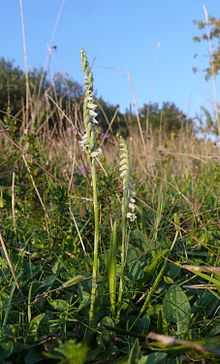 | |
| Scientific classification | |
| Kingdom: | Plantae |
| (unranked): | Angiosperms |
| (unranked): | Monocots |
| Order: | Asparagales |
| Family: | Orchidaceae |
| Genus: | Spiranthes |
| Species: | S. spiralis |
| Binomial name | |
| Spiranthes spiralis (L.) Chevall. | |
Spiranthes spiralis, commonly known as autumn lady's-tresses, is a palearctic orchid which in Europe blooms in August and September. It is characterised by a spiral inflorescence produced after the leaves have died down. The inflorescence can be very small (as little as 50 millimetres or 2.0 inches high) especially in short grazed grassland. In Western Europe it occurs most frequently in close cropped grassland overlying chalk or limestone.
Etymology
Spiranthes is the Greek word for twisted, spiralis is Latin for twisted or spiral.Both refer to the inflorescence.
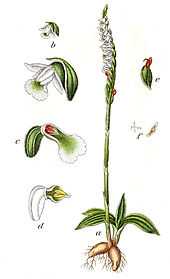
Description
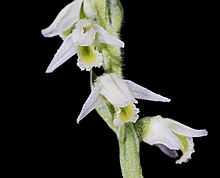
S. spiralis is a short tuberous perennial which reaches heights between 5 and 30 centimeters. The stem is stickily-hairy.The plant has two tubers as storage organs, rarely, one or three. From Autumn two new tubers are formed and the old tubers lowly die off. The shiny oval-elliptical foliage leaves form a basal rosette close to the ground and to one side of the flower-spike. There are from three to seven and they have a length of 1.5 to 3.5 cm and a width of 1 to 1.5 cm. The leaves are often withered by flowering time. The stem leaves are scale-like and overlapping;the bracts are shorter than the flowers.
The flowers are white, 6-7mm long. There are up to 20 borne in a slender spiral 3 to 12 cm long.The outer 2 sepals are spreading, the upper sepal and the petals fuse to form a tube with the lip. The lip has up-curved edges and is yellowish-green. The edge of the lip is notched and appears viewed up close as frayed.
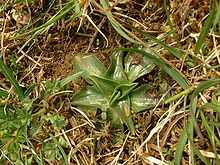
Growth cycle
The growth cycle differs from most other European orchids. Between July and August the flowering stem begins to grow. At this time, no leaves are visible. Between late August and early October, the leaves develop next to the flowering stem. They survive the winter and grow until the beginning of summer when they wither.The next flowering stem then grows from the center of the withered rosette of leaves .
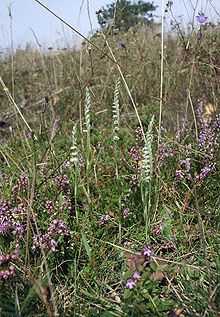
Habitat
Dry grassy places, meadows, garigue, heaths, pine woodland, generally on calcareous soils.
Range
The range of the species covers Europe, with the exception of the colder areas in the north, North Africa, Caucasus and North Iran eastwards to the Western Himalayas.[1] (Codes)[2]
The original source of S. spiralis is the Mediterranean. Only when the man from 7000 to 4000 BC, by settling and converting forests to agriculture and animal husbandry, created the habitat for this orchid and allowed it to spread to the north.
In Germany, the species is found in the Frankenhöhe, the Franconian Jura, the Swabian Jura and the Alps . There are a few locations in southern Saxony-Anhalt . Outside these areas, the species is only very rarely encountered. In the west and north-west Germany it is probably extinct at all former location.
In Austria, the species is still present in all provinces, but it is also rare.
In Switzerland the most current locations are Lake Lucerne, the Rhine Valley in Chur, in the area of Lake Walen and the Ticino.
In Italy was found also in the north-east near the seaside.
In Great Britain and Ireland its northern-most occurrence is on the Isle of Man. It has never been found in Scotland.[3]
In Ireland it has a scattered southern distribution north to County Sligo.[3]
In these countries the orchid grows on dry and semi-dry grasslands and heaths with regular grazing, where the accompanying vegetation is kept low. Very rarely, they can also be found in light coniferous forests.
Typical companion plants are often the Spiny restharrow Ononis spinosa, heather Calluna vulgaris and Euphrasia stricta.
Taxonomy
Among the synonyms are:
- Ophrys spiralis L. (basionym)
- Epipactis spiralis (L.) Crantz
- Serapias spiralis (L.) Scop.
- Ophrys autumnalis Balb.
- Neottia spiralis (L.) Sw.
- Neottia autumnalis (Balb.) Pers.
- Ibidium spirale (L.) Salisb.
- Spiranthes autumnalis (Balb.) Rich.
- Neottia autumnalis (Balb.) Steud.
- Gyrostachys autumnalis (Balb.) Dumort.
- Spiranthes glauca Raf.
- Gyrostachys spiralis (L.) Kuntze
References
- ↑ "World Checklist of Selected Plant Families".
- ↑ "World Checklist of Selected Plant Families TDWG Geocodes" (PDF).
- ↑ 3.0 3.1 Cotton, D.C.F.; Dunleavy, J (2009). "Spiranthes spiralis (L.) Chevall. (Autumn Lady's-tresses orchid), with notes on threats to its conservation status". Ir Nat. J 30: 70–73.
- Pierre Delforge, 2006 Orchids of Europe, North Africa and the Middle East Portland, Or. : Timber Press 3rd Edition ISBN 9780881927542
- Karl-Peter Buttler, 1986 Orchideen, die wildwachsenden Arten Europas. Mosaik Verlag ISBN 3-570-04403-3
- H. Baumann, S. Künkele, 1982 Die wildwachsenden Orchideen Europas. Frankh ISBN 3-440-05068-8
- Robert L. Dressler,1996 Die Orchideen - Biologie und Systematik der Orchidaceae.
- Hans Sundermann, 1975 Europäische und mediterrane Orchideen. Brücke-Verlag, 2. Auflage ISBN 3-871-05010-5
- J. G. Williams: Orchideen Europas mit Nordafrika und Kleinasien. BLV Verlag, ISBN 3-405-11901-4
- Nathalie Machon, Philippe Bardin, Susan J. Mazer, Jacques Moret, Bernard Godelle and Frederic Austerlitz, 2003 Relationship between genetic structure and seed and pollen dispersal in the endangered orchid Spiranthes spiralis New Phytologist(2003) 157: 677–687 pdf
External links
- Spiranthes spiralis at the Encyclopedia of Life
- Den virtuella floran - Distribution
- Orchids of Italy
- Acta plantarum
| Wikimedia Commons has media related to Autumn Lady's-tresses (Spiranthes spiralis). |
| Wikispecies has information related to: Autumn Lady's-tresses (Spiranthes spiralis) |
